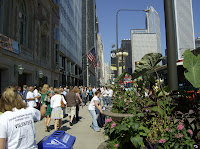
We return today to Charles Lindbergh’s insightful exploration of the inner self. He made some interesting observations as he was flying over the Atlantic one night in May, 1927, on his way to becoming the first person to fly solo from New York to Paris.
Like other adventurers before him, Lindbergh seemed to be as much an explorer of inner landscapes as he was of the outside world. As one reads the account, an interesting question comes into focus: does fatigue break down the mind-body distinction and give us new insight into other components of our being?
Here, in his own words, are Lindbergh’s notes from the 18th hour of his flight:
“Shaking my body and stamping my feet no longer has effect. It’s more fatiguing than arousing. I’ll have to try something else. I push the stick forward and dive down into a high ridge of cloud, pulling up sharply after I clip through its summit. That wakes me a little, but tricks don’t help for long. They’re only tiring. It’s better to sit still and conserve strength.
“My mind strays from the cockpit and returns. My eyes close, and open, and close again. But I’m beginning to understand vaguely a new factor which has come to my assistance. It seems I’m made up of three personalities, three elements, each partly dependent and partly independent of the others. There’s my body, which knows definitely that what it wants most in the world is sleep. There’s my mind, constantly making decisions that my body refuses to comply with, but which itself is weakening in resolution. And there’s something else, which seems to become stronger instead of weaker with fatigue, an element of spirit, a directive force that has stepped out from the background and taken control of both mind and body. It seems to guard them as a wise father guards his children; letting them venture to the point of danger, then calling them back, guiding with a firm but tolerant hand.
“When my body cries out that it
must sleep, this third element replies that it may get what rest it can from relaxation, but that sleep is not to be had. When my mind demands that my body stay alert and awake, it is informed that alertness is too much to expect under these circumstances. And when it argues excitedly that to sleep would be to fail, and crash, and drown in the ocean, it is calmly reassured, and told it’s right, but that while it must not expect alertness on the body’s part, it can be confident there’ll be no sleep.
“My eyes, under their weighted lids, seem completely disconnect from my body, to have within themselves no substance, to be conscious rather than to see. They become a part of this third element, this separate mind which is mine and yet is not, this mind both far away in eternity and within the confines of my skull, within the cockpit and outside of it at the same moment, connected to me and yet unlimited to any finite space.
“During long ages between dawn and sunrise, I’m thankful we didn’t make
The Spirit of St. Louis a stable plane. The very instability which makes it difficult to fly blind or hold an accurate course at night now guards me against excessive errors. It’s again a case of the plane and me compensating for each other…”
Notes:1. Photograph of
The Spirit of St. Louis in the Smithsonian Air and Space Museum is courtesy of Wikimedia Commons (Public Domain), under the terms of the GNU Free Documentation License
2. Book excerpt:
The Spirit of St. Louis, by Charles Lindbergh, 1953, Charles Scribner's and Sons, New York, pages 361-362 (1956 edition).
-------------
> To send this to a friend, click on the envelope icon.
 This is a quick drawing of the Old State House in Boston. I drew it with ink, but turned it into a negative on the computer because this reminds me of some old historical prints.
This is a quick drawing of the Old State House in Boston. I drew it with ink, but turned it into a negative on the computer because this reminds me of some old historical prints.






















